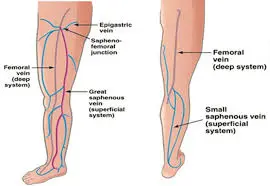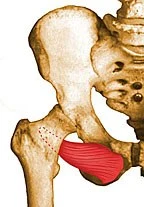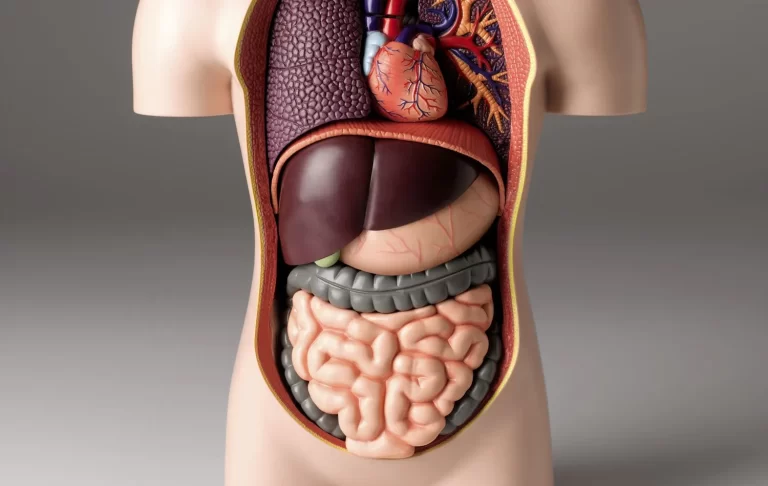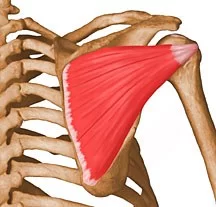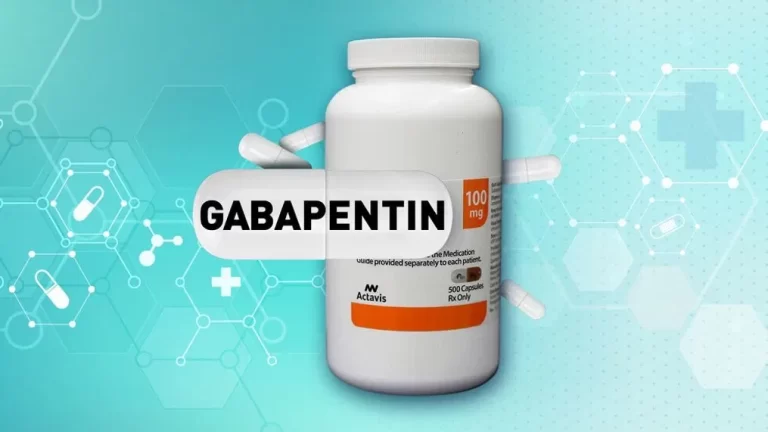Great Saphenous Vein
The great saphenous vein (GSV) is a major superficial vein of the lower limb, playing a crucial role in the circulatory system. It is the longest vein in the human body, running along the medial aspect of the leg from the dorsum of the foot to the groin.
The GSV is responsible for draining blood from the superficial tissues of the lower limb and carries it back towards the heart.
The superficial veins in your legs are the big saphenous vein and the little saphenous vein. They gather oxygen-depleted blood from a network of tiny veins in your legs and feet. This blood is carried by your saphenous veins to deep veins where it can continue to flow back to your heart. Varicose veins frequently affect saphenous veins and may need therapy.
Overview
What is the saphenous vein?
Saphenous veins are blood vessels in your legs that assist in returning blood from your legs and feet to your heart. Your legs each have two saphenous veins. They are known as the large saphenous vein and the tiny saphenous vein. Your great saphenous vein, also known as your long saphenous vein, is the longest vein in your body, running the length of your body.
Anatomy of Saphenous Vein
Location
Saphenous veins are superficial veins found in the legs. Superficial veins are closer to the surface of your skin than deep veins (which are deeper within your body). The great saphenous vein extends from the foot to the thigh. Your saphenous vein runs from the bottom of your foot to the back of your knee.
Both your great saphenous vein and your little saphenous vein start at the top of your foot. They branch out from the dorsal venous arch of the foot, which is a network of small veins that transports blood from your foot to your saphenous vein. The great saphenous vein begins at the vein’s medial end, or the end closest to the center of your body.
Your great saphenous vein then ascends along the inner surface of your leg. Other veins drain into your great saphenous vein along the route. The great saphenous vein terminates in the upper thigh. Your great saphenous vein empties into a deep vein called the femoral vein at this point.
Your little saphenous vein starts at the lateral end of your foot’s dorsal venous arch. This is the end closest to the outside of your foot. Your saphenous vein then goes up the back of your calf and finishes behind your knee. It empties into the popliteal vein. This is a large vein that connects to your femoral vein.
What is the Saphenous Vein made of?
The saphenous vein walls are composed of three layers of tissue:
- The outer layer of your vein, known as the tunica adventitia, provides it with structure and shape.
- Smooth muscle cells are found in the tunica medium (middle layer). As blood passes through your vein, these cells allow it to dilate or constrict.
- The tunica intima (inner layer) has a smooth endothelial cell lining.
- These cells allow blood to flow freely through your veins.
- Each of your saphenous veins has multiple one-way valves that let your blood flow in the right direction and prevent it from flowing in the wrong direction.
- The number of valves varies depending on the individual. The majority of people have 10 to 12 valves in their great saphenous vein.
- These valves, together with the squeezing of adjacent muscles, assist your blood in defying gravity as it rushes upward into your heart.
Course of Saphenous Vein
The great saphenous vein arises from the hallux dorsal vein, which joins with the dorsal venous arch of the foot. The vein then proceeds anteriorly to the medial malleolus (an easy location to find the vein). The vein ascends the medial surface of the leg before running posterior to the femoral medial epicondyle. It then runs upward in the thigh, passing over the medial surface.
It is connected to branches of the medial femoral cutaneous nerves in the thigh, and it is closely linked to the saphenous artery (a branch of the descending genicular artery) at the knee, leg, and foot. The great saphenous vein then flows through the saphenous aperture in the fascia lata. It continues as an arch to join the femoral vein within the femoral triangle’s medial portion.
Femoral triangle
- The great saphenous vein is the femoral triangle’s medialmost feature. A gap lateral to it allows for vein expansion with increased venous return.
- The femoral artery runs on the opposite side of the great saphenous vein. The femoral nerve (posterior divisions of the anterior rami of spinal nerves L2-L4) is the most lateral structure, running close to the anterior superior iliac spine and beneath the inguinal ligament.
- This vein contains several valves that ensure blood flows in the proper direction.
- A valve separates the superficial and deep venous systems by covering the saphenofemoral junction (where the saphenous vein crosses the femoral vein).
- Smaller veins from the ankle and foot enter the large saphenous vein. The medial marginal vein (which drains the sole) and the small saphenous vein (which has several connections with its smaller equivalent in the lower leg portion) are two examples.
- It is related to a short saphenous vein and deep veins in the leg via perforating veins.
- It has three large tributaries near the knee, and many tributaries in the thigh, including posteromedial i.e. accessory saphenous vein, anterolateral in the essence of anterior femoral cutaneous vein, and peri-inguinal superficial epigastric, superficial circumflex iliac, and superficial external pudendal veins.
- As the vein travels up the thigh, it receives connecting branches from the popliteal vein via another perforator, as well as from the common femoral vein.
Structure of Great Saphenous Vein
- The great saphenous vein emerges at the point where the dorsal vein of the big toe (the hallux) joins the dorsal venous arch of the foot.
- It runs up the medial side of the leg after passing in front of the medial malleolus (which may often be viewed and palpated).
- At the knee, it runs over the posterior border of the femur bone’s medial epicondyle. The great saphenous vein enters the cribriform fascia of the saphenous aperture in the proximal anterior thigh 3-4 centimeters (1.2-1.6 in) inferolateral to the pubic tubercle.
- It creates an arch, the saphenous arch, to join the common femoral vein in the region of the femoral triangle at the saphenofemoral junction.
- The great saphenous vein receives branches from the sole via the medial marginal vein at the ankle; in the lower leg, it anastomoses freely with the small saphenous vein, communicates with the anterior and posterior tibial veins via perforator veins (Cockett perforators), and receives many cutaneous veins; near the knee, it communicates with the popliteal vein via the Boyd perforator; in the thigh.
- The superficial epigastric, superficial circumflex iliac, and superficial external pudendal veins join it near the fossa ovalis.
- The thoracoepigastric vein connects the femoral vein to the axillary vein and extends along the lateral portion of the trunk between the superficial epigastric vein below and the lateral thoracic vein above.
Function of great saphenous vein
- Like other veins in your body, your saphenous veins return oxygen-depleted blood to your heart. Many of your legs and feet’s smaller veins flow into your saphenous veins.
- This blood is subsequently carried by your saphenous veins to veins in your upper legs.
- Your blood then continues upward to your inferior vena cava. This is a big vein that leads directly to your heart.
- Your saphenous veins are part of the circulatory system of your body. Your circulatory system maintains your blood circulating through your body in a continuous cycle.
- Your blood is always moving. This is because it must transport oxygen and nourishment to all of your organs and tissues. “This happens every minute of every day.”
- The roadways that convey blood on this journey are blood vessels, including your saphenous veins.
- Arteries transport blood away from your heart, whereas veins transport blood toward it.
- You might be asking why my blood always has to return to my heart.
- The reason for this is that your heart delivers blood to your lungs with each beat, where it can receive oxygen and expel carbon dioxide.
- After leaving your lungs, your blood returns to your heart.
- This oxygen-rich blood is subsequently returned to your body by your heart.
- Your blood enters your veins to begin its journey back to your heart after delivering oxygen and nourishment. And so the cycle goes on.
Tributaries
Several veins connect to the great saphenous vein, however not all of them are present in every person. The majority of them connect it at varied average distances from its junction with the common femoral vein (CFV):
| Vein | Presence | Joins from direction | Joins at average distance from CFV junction |
| Superficial circumflex iliac vein | 83% | Lateral | 10.8mm |
| Superficial epigastric vein | 78% | proximal | 11.9 mm |
| Superficial external pudendal vein | 90% | Medial | 16.9 mm |
| Anterior accessory saphenous vein | 51% | Lateral | 20.5 mm |
| Posterior accessory saphenous vein | 73.9 mm |
Clinical importance
Pathology of the great saphenous vein is relatively frequent, although usually not life-threatening in isolation.
Varicose veins:
Like other superficial veins, the great saphenous vein can become varicose; bloated, twisted, and extended, and typically regarded ugly. Varicose veins are not life-threatening, and there are several treatment options available. When the vein’s diameter is too large for the valves within it to completely coapt, the resulting condition, chronic venous insufficiency, can cause skin color changes in the calf and ulcers that can last for years if the vein is not ablated.
Thrombophlebitis:
The GSV has the ability to thrombose. This form of GSV phlebitis is usually not fatal in isolation; however, if the blood clot is near the sapheno-femoral junction or a perforator vein, a clot fragment can move to the deep venous system and the pulmonary circulation. It can also be associated with or proceed to deep vein thrombosis, which must be treated as soon as possible. Ultrasonography is used to determine whether a GSV thrombosis has these consequences.
Use in cardiovascular procedures
When arterial grafts are unavailable or a large number of grafts are required, such as in a triple bypass or quadruple bypass, cardiac surgeons frequently extract the vein and use it for autotransplantation in coronary artery bypass surgeries.
When available, the great saphenous vein is the conduit of choice for vascular surgeons undertaking peripheral artery bypass surgeries. Even after engraftment, the saphenous vein possesses superior long-term patency compared to synthetic grafts (PTFE, PETE (Dacron), human umbilical vein grafts, or biosynthetic grafts [Omniflow]. It is frequently employed in situ (in place), after tying off smaller tributaries and destroying the venous valves with a valvulotome, such as LeMaitre’s valvulotome.
The saphenous vein removal will not affect normal leg circulation. The blood that was previously flowing through the saphenous vein will now take a different path. Collateral circulation is the term used to describe the alternative blood flow route that develops in response to a blockage in a primary blood vessel.
The saphenous nerve, which runs along the upper half of the great saphenous vein, is a femoral nerve branch. It can be damaged during vein surgery.
Conditions and disorders
Saphenous veins and other veins in your legs may be affected by vein disorders. These disorders prohibit your veins from functioning normally. Here are several examples:
Varicose veins are swollen, bulging veins visible on the surface of the skin. They are usually innocuous, but they can occasionally cause consequences such as skin ulcers (open sores).
Chronic venous insufficiency occurs when the one-way valves in your leg veins are compromised. Rather than moving smoothly up to your heart, blood pools in your veins. Leg swelling and soreness in the affected leg can result from this.
Chronic venous insufficiency occurs when the one-way valves in your leg veins are compromised. Rather than moving smoothly up to your heart, blood pools in your veins. Leg swelling and soreness in the affected leg can result from this.
Superficial thrombophlebitis is a blood clot that originates in a superficial vein immediately under the skin.
Signs and symptoms of saphenous vein disease
The saphenous vein or other leg vein problems may result in:
- Swelling (edema) in the legs, ankles, or feet, specifically after standing for a long period.
- Tenderness or pain.
- Legs that are achy, weary, or throbbing.
- Your legs have leathery skin.
- Skin flaking or itching on your legs or feet.
What tests are used to evaluate the saphenous vein’s health?
A physical exam may usually tell your provider whether there are any issues with your saphenous vein. To understand more, your practitioner may also perform a vascular ultrasound. They may also examine your blood for signs of infection or abnormal blood clotting.
What are the most common saphenous vein treatments?
Treatment is determined by your condition. Typical treatments include:
Lifestyle changes- Lifestyle changes may be recommended by your provider to deal with varicose veins. These include frequently lifting your legs and using compression stockings. Your doctor may also advise you to increase your physical activity.
Sclerotherapy: A solution is injected into your varicose vein to help it fade over time.
Endovenous thermal ablation: A catheter (tube) and laser are used by your provider to shut off the injured vein.
Vein ligation and stripping: Your surgeon ties off the injured vein and removes it.
Blood thinners: If a blood clot forms in the location, your doctor may recommend blood thinners to treat it.
Types of Saphenous Vein Problems
In essence, saphenous veins can and do fail for two reasons.
For starters, it can form a blood clot, resulting in thrombosis, or the vein’s valves can collapse, resulting in blood pooling or “reflux.” As a result, a disease known as venous incompetence or chronic vein insufficiency develops.
Blood Clot in the Great Saphenous Vein
Although venous clots can form for no apparent reason in rare instances, the great majority of thromboses are caused by one of three diseases. These are…
- Long durations of idleness are frequently the cause of decreased blood flow.
- Changes in the immune system, such as disease, frequently produce an increase in the activity of the blood clotting system.
- A vascular injury induced by a collision, knock, or trauma.
- A blood clot in the GSV is frequently diagnosed by a warm, sensitive, or hurting sensation in the leg. It can also cause edema in some circumstances.
- A blood clot in the GSV is frequently diagnosed by a warm, sensitive, or hurting sensation in the leg. It can also cause edema in some circumstances.
- The most important thing to remember about blood clots is that, while the condition itself is not life-threatening, fragments of the clot can break off and go to the lung, where they can stay trapped.
- This is known as a pulmonary embolism, and it can be fatal if not recognized and treated promptly.
Causes
Causes and risk factors for chronic venous insufficiency. Chronic venous insufficiency is caused by faulty or damaged valves.
The following are some risk factors that might contribute to weak or broken valves:
- Varicose veins in the family or personal history
- Being over the age of 50
- Obesity
- Being female
Treatment of blood clot in saphenous vein
In the therapy of thrombolytic disorders, a combination of cautious management, compression, and mobilization is essential. When combined with carefully designed exercise, bandages and graduated compression stockings can help to eliminate a clot.
Nonsteroidal anti-inflammatory medicines (NSAIDs) or anticoagulants may also be used to assist in dissolving the clot.
If the patient does not respond to the aforementioned treatments, surgical techniques can be used. However, surgery such as vein stripping or ligation is usually reserved as a last resort.
All veins have valves in insufficiency, and the valves and veins should come together as the calf muscle pushes blood out of the leg, and the valve should close behind it as it passes the valve. In patients with insufficiency, the cusps of the valves do not come together, causing blood to flow backwards. It rushes back down the leg towards the ankle, causing the veins to dilate due to the pressure. These veins dilate and eventually become varicose.
Reflux of the Saphenous Vein
A series of valves can be found in any vein, including the great saphenous vein. Their main role is to direct and control blood flow by pushing it upwards toward the heart. In cases of chronic venous insufficiency (CVI), these valves can fail, allowing blood to flow back down the leg due to gravity. Blood can flow backward from the heart to a patient’s ankle through the saphenous vein in particular. This causes varicosities (varicose veins) by stretching the main smaller veins coming from the big saphenous vein, or it might cause irritation or damage to the hundreds of tiny capillaries.
Swelling, soreness, or weariness in the limb area, as well as noticeable red or brown areas around the ankle, are symptoms of the latter. In either case, neither condition is particularly comfortable for the patient.
What about saphenous vein reflux treatments?
The following are some treatment options for saphenous vein reflux (incompetence):
- Radiofrequency ablation is a non-surgical procedure that uses heat to reduce troublesome veins or capillaries.
- Laser ablation of a faulty saphenous vein
- Chemical ablative procedures that make use of body-friendly foam or glue
- Mechanical ablation with a tiny device, and eventually, as a last option, traditional open surgery in which the affected vein is totally removed.
- The sort of treatment performed will be greatly influenced by the condition, needs, and requirements of the patient. The good news is that the vast majority of these treatments are non-invasive and effective.
So there you have it: everything you need to know about saphenous vein problems, why they happen, and how to treat them.
The best way to avoid GSV insufficiency is to maintain a healthy weight and to keep physically active.
Great saphenous veins incompetence
The valves and the great saphenous vein are inadequate in great saphenous insufficiency. They no longer work regularly. The most prevalent type of varicose vein that we observe is great saphenous insufficiency.
The long saphenous vein travels from the groin to the ankle, while the short saphenous vein goes up the back of the legs from the ankle to behind the knee. The great saphenous vein, which extends from the groin to the ankle and thigh of the leg, is the most commonly affected.
Pregnancy
Deep vein thrombosis (DVT) is a blood clot that forms in a vein deep under the skin.
Long periods of sitting or standing
Being physically sedentary
Smoking
Symptoms
Symptoms of chronic venous insufficiency include:
- Leg heaviness, exhaustion, soreness, lethargy, edema, or pain.
- Discoloration of the skin in the center of the calf or ankle.
- Skin ulcers are non-healing sores on the skin.
FAQ
What exactly is the saphenous vein?
The great saphenous vein (GSV), also known as the long saphenous vein (/sfins/), is a big, subcutaneous, superficial vein in the lower leg. It is the body’s longest vein, spanning the length of the lower limb and returning blood from the foot, leg, and thigh to the deep femoral vein at the femoral triangle.
The great saphenous vein has how many valves?
The GSV contains 10 to 12 valves, which are more numerous in the leg than in the thigh and are typically positioned close below the perforated veins. The saphenous vein has been reported to have 8 to 20 valves, several of which are located below the knee.
What is the primary function of the great saphenous vein?
The primary function of the great saphenous vein is to drain deoxygenated blood from the foot and superficial regions of the leg and knee (closer to the surface). This is back to the heart and lungs, where oxygen and nutrients are regenerated before being delivered to the remainder of the body.
What is the significance of the name “great saphenous vein”?
When the origin of the word saphenous is debated, most agree that it stems from the Greek word safaina, which means “evident.” The caudal section of the vein was known solely to the ancient Greeks, and neither the Greeks nor the Romans used saphena.
Is it necessary to use a huge saphenous vein during CABG?
The saphenous vein was the first bypass conduit utilized in CABG, and it is still the most widely used bypass conduit today, except revascularization of the left anterior descending coronary artery (LAD).
References
- Professional, C. C. M. (n.d.). Saphenous vein. Cleveland Clinic. https://my.clevelandclinic.org/health/body/23946-saphenous-vein
- Wikipedia contributors. (2023, October 7). Great saphenous vein. Wikipedia. https://en.wikipedia.org/wiki/Great_saphenous_vein
- Goke Akinwande, MD. (n.d.). Saphenous vein problems – What are they and why do they occur?: Midwest Institute for Non-Surgical Therapy: Vascular and Interventional Radiologists. https://www.mintstl.com/blog/saphenous-vein-problems-what-are-they-and-why-do-they-occur
- Great and small saphenous veins insufficiency Montreal treatment. (n.d.). Dr. Ricardo Ruz. https://drricardoruz.com/condition/greater-or-lesser-saphenous-veins/

